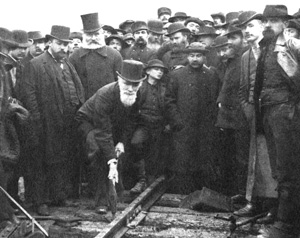 THUNDER BAY – Our community has a long history as a transportation hub. The railway has, in the past served as a key component of Fort William and Port Arthur’s economic growth. The railway is an important part of Canada, and our community’s history.
THUNDER BAY – Our community has a long history as a transportation hub. The railway has, in the past served as a key component of Fort William and Port Arthur’s economic growth. The railway is an important part of Canada, and our community’s history.
The “National Dream” of building the trans-continental railway across Canada helped to build Canada as a nation. Over the weekend, the 125th Anniversary of the completion of that project was celebrated.
On November 7th, 1885, a modest ceremony was held at Craigellachie, on the western edge of Eagle Pass in British Columbia’s Monashee Mountains. Canadian Pacific (CP) crews had been laying track in the pass throughout the summer and fall. On that cloudy November morning, CP director Donald Smith, later known as Lord Strathcona and Mount Royal, drove the symbolic last spike on Canada’s first transcontinental railway.
In 1971, the Historic Sites and Monuments Board of Canada (HSMBC) officially designated the completion of Canada’s first transcontinental railway as an event of national significance. Eagle Pass National Historic Event commemorates the communal achievement of thousands of workers, engineers, managers, politicians, and planners who enabled the building of the CP. Eagle Pass, first earmarked for the railway by Walter Moberly in 1865, was one of the last stretches of the line to be completed.
In 1985, the HSMBC installed a replacement Eagle Pass plaque at Craigellachie. Today, the site of the Last Spike at Craigellachie is managed by the Revelstoke Railway Museum and the BC Ministry of Transportation.
The completion of the CP Railway was undeniably a turning point in Canadian history. It cemented British Columbia’s place in Confederation, enabled the resettlement of the West, and had lasting impacts on everything from government policy to individual lives. In 1871, British Columbia had agreed to enter Confederation in part due to the promise of a railway; in driving the Last Spike, the province was finally connected by rail to the East. The new railway shaped relations between central and western Canada, sheltered Canada against American expansionism, and enabled the growth of western industries like ranching, farming, forestry, mining and tourism.
The CP also played a critical role in establishing Canada’s system of national parks. “If we can’t export the scenery, then we’ll have to import the tourists,” said CP’s man at the helm and chief promoter William Cornelius Van Horne who suggested the creation of Canada’s first national parks along the CP line.
As early as the 1880s, Van Horne went about promoting western Canadian tourism. In 1885, the federal government set aside a system of Rocky Mountain hot springs which CP workers had brought to their attention. These springs today form the core of Banff National Park.
Other locations suggested by CP would lead to the creation of Yoho and Glacier National Parks. For several decades, CP was also responsible for most national park tourist infrastructure and promotion.
The vast majority of early park visitors arrived on CP trains, and the company created effective advertising campaigns that promoted the parks as world-class travel destinations helping set up Canada’s first national park and building iconic CP hotels offering spa retreats, mountaineering with Swiss guides, and elegant railway hotels.
This year, Parks Canada and Canadian Pacific celebrated the 125th anniversaries of Banff National Park and driving the Last Spike. Next year will mark the 125th anniversaries of both Glacier and Yoho National Parks and the 100th anniversary of the National Parks Service.
